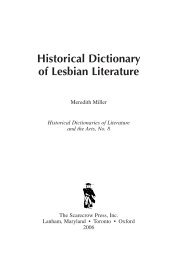Founded by Friends : the Quaker heritage of fifteen - Scarecrow Press
Founded by Friends : the Quaker heritage of fifteen - Scarecrow Press
Founded by Friends : the Quaker heritage of fifteen - Scarecrow Press
You also want an ePaper? Increase the reach of your titles
YUMPU automatically turns print PDFs into web optimized ePapers that Google loves.
xviii Thomas D. Hamm<br />
<strong>the</strong> mid-twentieth century, <strong>the</strong>y preferred <strong>the</strong>ir own alumni (or graduates<br />
<strong>of</strong> non-<strong>Quaker</strong> schools that <strong>the</strong>y perceived as “sound”) to <strong>Quaker</strong>s who<br />
might be tainted with modernism. The o<strong>the</strong>r force was a growing emphasis<br />
on pr<strong>of</strong>essionalization. As <strong>Quaker</strong> colleges became more diverse<br />
and more responsible to diverse constituencies, <strong>the</strong>y have cast wider nets<br />
in looking for leaders. At a majority <strong>of</strong> <strong>Quaker</strong> colleges, it apparently is no<br />
longer an expectation that <strong>the</strong> chief executive <strong>of</strong>ficer be a member <strong>of</strong> <strong>the</strong><br />
Society <strong>of</strong> <strong>Friends</strong>.<br />
PATTERNS OF DEVELOPMENT<br />
Certain patterns <strong>of</strong> development are clear in <strong>the</strong> history <strong>of</strong> all <strong>the</strong>se institutions.<br />
One is how money talks. The generosity <strong>of</strong> eastern <strong>Friends</strong>, especially<br />
in Philadelphia, meant that Haverford, Swarthmore, and Bryn<br />
Mawr were relatively secure from <strong>the</strong> beginning. This also allowed <strong>the</strong>m<br />
to avoid <strong>the</strong> strictures that <strong>the</strong> need to rely on a yearly meeting for financial<br />
support would have caused. Some <strong>of</strong> <strong>the</strong>se colleges, most notably<br />
Earlham with its ties to <strong>the</strong> Lilly family <strong>of</strong> Indianapolis, have been skillful<br />
in cultivating wealthy donors, <strong>of</strong>ten without <strong>Quaker</strong> ties. In <strong>the</strong> case <strong>of</strong><br />
Malone, money stimulated migration, as eminent-domain funds from<br />
freeway construction and a bargain-basement land <strong>of</strong>fer moved <strong>the</strong> campus<br />
from Cleveland to Canton in 1956. More common is a realization, usually<br />
early in <strong>the</strong> history <strong>of</strong> <strong>the</strong> institution, that survival meant attracting<br />
and enrolling non-<strong>Quaker</strong> students. That was <strong>of</strong>ten a source <strong>of</strong> dramatic<br />
conflict because it inevitably led to a relaxing <strong>of</strong> some <strong>of</strong> <strong>the</strong> elements <strong>of</strong> a<br />
guarded education.<br />
The development at most colleges, in <strong>the</strong> late nineteenth and early<br />
twentieth centuries, <strong>of</strong> what historian Helen Lefkowitz Horowitz calls<br />
“campus culture” was a direct outgrowth <strong>of</strong> this urge for survival. Thus,<br />
we find in most <strong>of</strong> <strong>the</strong>se chapters accounts <strong>of</strong> <strong>the</strong> development <strong>of</strong> athletics,<br />
especially football, and <strong>the</strong> conflicts that this sometimes brought with<br />
constituencies, most notably <strong>the</strong> attempt <strong>of</strong> a disapproving Philadelphia<br />
Friend to buy out Swarthmore’s football team with a million-dollar bequest<br />
early in <strong>the</strong> twentieth century. Later, students agitated for o<strong>the</strong>r<br />
changes that would make <strong>the</strong>ir <strong>Quaker</strong> colleges more like o<strong>the</strong>r schools.<br />
At some places, such as Wilmington and Swarthmore, that meant <strong>the</strong> development<br />
<strong>of</strong> fraternities and sororities. At several institutions, it meant<br />
<strong>the</strong> acceptance <strong>of</strong> academic honoraries like Phi Beta Kappa. By <strong>the</strong> 1920s,<br />
it meant agitation <strong>by</strong> students for <strong>the</strong> end <strong>of</strong> campus rules against smoking<br />
and dancing. The exceptions that prove <strong>the</strong> rule are <strong>Friends</strong>, Malone,<br />
and Barclay. A commuter institution throughout its history, <strong>Friends</strong> never<br />
experienced significant debate over regulating <strong>the</strong> lives <strong>of</strong> its relatively
















